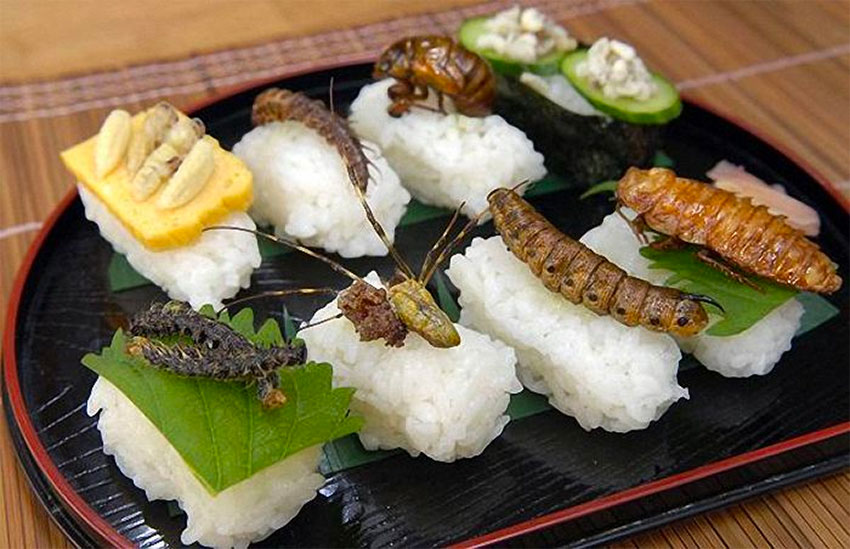The event is described as an invitation to reflect on what we eat and the impact it has on the environment
by the El Reportero’s news services
Interested in exploring gastronomic opportunities in the insect world? An upcoming exhibition will probably provide all the necessary information.
The Art of Eating Insects”opens at Mexico City’s San Ildefonso College on Oct. 9 to highlight communities that consume insects, as well as the history and future sustainability of the practice.
It will include 180 pieces from 23 research collections, including scientific illustrations, paintings, historical objects, photographs, video and mixed media presentations.
Also on display will be many specimens of insects eaten in Mexico, such as grasshoppers, atta ants (as in leaf-cutters), honey ants, escamoles (ant eggs), chicatanas (flying ants that appear after the first rains) and aquatic bugs called ahuautle, among others.
A press conference held to announce the event was told there are 1,950 edible insects in the world, of which Mexico incorporates 545 into its cuisine as part of traditional diets.
San Ildefonso expositions curator Carmen Tostado Gutiérrez said the idea for the exhibit came from talks with the National Commission for the Knowledge and Use of Biodiversity (Conabio) about Mexico’s cultural heritage and a growing interest in eating insects.
Its goal, however, is to create historical and ecological awareness of what we eat.
“It’s more than an invitation to eat insects,” said Tostado, “it’s about knowing where this culinary tradition comes from, how it was created throughout the course of history . . . It’s more of an invitation to reflect on what we’re eating and the impact it has on the environment, questioning our role, consumption and personal attitudes on a daily basis.”
San Ildefonso executive coordinator Eduardo Vásquez Martín highlighted the exhibition’s goal as a tribute to the environment and to show the public the role insects play in it. He hopes the exhibit will encourage more people to try Mexican insect recipes.
The exhibition will also have illustration workshops for children, courses for the general public and 3-D insect modeling classes, all with the goal of contributing to the solution of environmental degradation.
It will run Tuesdays through Sundays from 10 a.m. to 6 p.m. until Feb. 2.
Source: El Universal (sp)
Symposium about the Joropo begins in Venezuela
A symposium about the different genres of the joropo, native Venezuelan rhythm, begins this Saturday at the headquarters of the Center for Cultural Diversity in this capital.
During the day, specialists such as Milagros Figueroa, Carlos Garcia, Jesus ‘Chuito’ Rangel, Monico Marquez and Jose ‘Cheo’ Hurtado, will talk about the eastern Joropo and Guayana.
Benito Irady and Alexander Lugo will introduce the debate, which will include numerous audiovisual testimonies of well-known musicians from the states of Nueva Esparta and Sucre.
Meanwhile, other presentations will address the central joropo, the jorconeao, the Andean, the colonist, the western, the llanero and many more variants that exist in various regions of the country.
Starting this morning, a panel made up of virtuous interpreters and scholars of the Eastern genre will contribute ideas to extend this variant of the Venezuelan Joropo to the Guayana region.
The joropo, a traditional form of music and dance that fully identifies the Venezuelan people, is now a symbol of national identity and its origins date back to the mid-1700s, when Venezuelan peasants preferred to use the term ‘joropo’ rather than ‘fandango’ to refer to parties and social and family gatherings.
Fandango is a Spanish term, which identifies one of the most popular songs and dances within flamenco, and from there seems to have taken the name that musical expression and dance. The genre is characterized by its mestizaje, the most authentic expression of the Venezuelan, which mixes the rhythm of the melody, the accompaniment of the harp and the cuatro, and letters of European influence, while also identifying the presence of black and indigenous footprint.
It is not only a musical style, it is also a dance, and represents a popular festival, a joyful dance that amuses and gathers its participants, and in each geographical area takes its own essence, develops different steps and figures, in addition to the basic ones that identify them.



